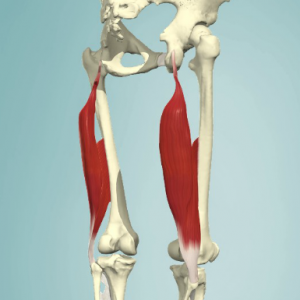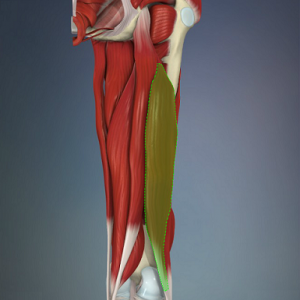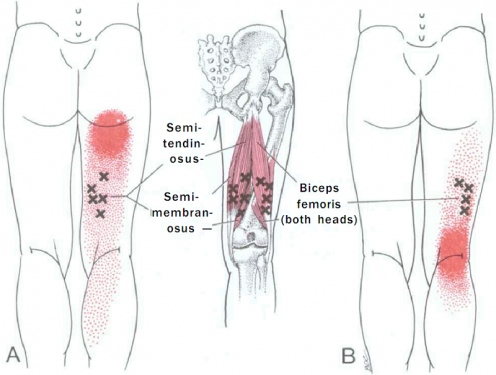Biceps Femoris
Original Editor - Evan Thomas
Top Contributors - Sai Kripa, Evan Thomas, Kim Jackson, Joao Costa, Ahmed M Diab, 127.0.0.1, George Prudden and WikiSysop
Description[edit | edit source]
Biceps femoris is a muscle of the posterior compartment of the thigh, and lies in the posterolateral aspect. It arises proximally by two 'heads', termed the 'long head' (superficial) and the 'short head' (deep). It is part of the hamstrings.[1]
| [2] | [1] |
|---|
Anatomy[edit | edit source]
Origin[edit | edit source]
- Long head: ischial tuberosity[3]
- Short head: linea aspera and lateral supracondylar line of the femur[3]
Insertion[edit | edit source]
Lateral aspect of fibular head[3]
Nerve Supply[edit | edit source]
- Long head: tibial division of the sciatic nerve (L5-S2)[3]
- Short head: common peroneal division of the sciatic nerve[3]
Blood Supply[edit | edit source]
Perforating branches of profunda femoris, inferior gluteal, and medial circumflex femoral arteries[3]
Function[edit | edit source]
Actions[edit | edit source]
- Long head: flexes the knee, extends hip, laterally rotates lower leg when knee slightly flexed, assists in lateral rotation of the thigh when hip extended[1][3]
- Short head: flexes the knee, laterally rotates lower leg when knee slightly flexed[1][3]
Functional contributions[edit | edit source]
- Through a reversed origin insertion action, the long head gives posterior stability to the pelvis[4]
- Both heads provide rotary stability by preventing forward dislocation of the tibia on the femur during flexion[4]
- Its contributions to the arcuate ligament complex at the posterolateral corner of the knee also provides varus and rotatory stability to the knee[4]
Clinical relevance[edit | edit source]
We know that biceps femoris muscle usually has 2 heads, namely short head and long head of biceps femoris. These two heads insert on the head of fibula, where at the site of insertion they divide into two portions by fibular collateral ligaments. Any sort of subluxation or dislocation of biceps femoris tendon or abnormal insertion of the tendon, and any or no trauma, meniscal instability can lead to Snapping Biceps Femoris Tendon. It is an unusual condition with symptoms of pain on the lateral side of knee, fibular head will be prominent, painful snap on lateral aspect of knee during active and passive knee flexion at 90 degrees and difficulty in performing ADL’s or sport related activities. As it is a rare phenomenon and there are very few articles published related to this condition. Furthermore, the exact pathology leading to snapping biceps femoris tendon is still unknown. However, according to researches, occurrence of this condition could be either due to overuse, prolong sporting or congenital[5][6].
While performing sprinting there will be an abrupt raise or alter in speed of running due to which biceps femoris muscle and semitendinosis present at the back of your thigh are usually hurt causing over stretching of such muscles. The injury to Long head of biceps femoris tendon and semitendinosis are most common among soccer players leading to sport related injuries[7].
Techniques[edit | edit source]
Palpation[edit | edit source]
- Position the client in prone lying with the knee in slight flexion[8]
- Starting distally locate the lateral proximal border of the popliteal fossa to locate the insertion of the tendon[8]
- Palpate the hamstrings laterally to locate the biceps femoris[8]
- Move palm toward the ischial tuberosity (proximally) to locate the muscle belly of the biceps femoris[8]
Length Tension Testing / Stretching[edit | edit source]
- With one hand, palpate the patient's ASIS and iliac crest with your thumb and index finger[9]
- With the other hand, support the patient's leg just above the ankle[9]
- Raise the patient's leg into hip flexion keeping the knee extended, and add internal rotation of the tibia to bias the biceps femoris[9]
- Flexibility of the biceps femoris is exhausted when the innominate starts to rotate posteriorly[9]
Trigger Point Referral Pattern[edit | edit source]
- Pain referred from TrPs in the lower half of the biceps femoris (long or short head) focuses on the back of the knee and may extend up the posterolateral area of the thigh as far as the crease of the buttock.[10]
Treatment[edit | edit source]
Stretching[edit | edit source]
- Position of patient is side lying and support is provided to lower leg with hip and knee flexed[11]
- Hold the upper leg and bring into abduction[11]
- During abduction, try to support the leg against your body, so that the patient can extend the knee whilst pressing the hip into flexion[11]
- With one hand, hold the upper leg and with thenar of your other hand try to provide stretch to the muscle away from the site of insertion[11]
Quadriceps foam rolling[edit | edit source]
The present study offers findings that foam rolling to quadriceps alone is effective in decreasing the activation of biceps femoris muscle. Foam rolling on patients muscle can lead to alteration in range of motion, performance and muscular co-activation around the particular joint. According to the researcher, when there is simultaneous contraction of the agonist and antagonist muscle, it helps in providing stability to the knee joint. However, if any disturbance occurs to the stability of the joint, the knee particularly goes for injury. Furthermore, the study portrays about ACL injury, which is more common due to alteration in muscular co-activation, and further research is required to identify the efficacy of foam rolling on activation of muscle around the knee joint[12].
Soft tissue mobilization[edit | edit source]
Performing soft tissue mobilization via IASTM to gluteals, IT band, Quadriceps, adductors and hamstrings, twice per week for 3 weeks helps in improving the knee extension range of motion among patients suffering from decrease in flexibility or decrease movement range due to soft tissue limitations[13].
Resources[edit | edit source]
This video is a good summary of the functions of the biceps femoris muscle.[14]
References[edit | edit source]
- ↑ 1.0 1.1 1.2 1.3 Primal Pictures. Available from:http://www.anatomy.tv/interactivehip (accessed 8 May 2015)
- ↑ Primal Pictures. Available from: https://www.anatomy.tv/#bicepsfemoris (accessed 8 May 2015).
- ↑ 3.0 3.1 3.2 3.3 3.4 3.5 3.6 3.7 Netter FH. Atlas of Human Anatomy. Philadelphia: Elsevier,2014
- ↑ 4.0 4.1 4.2 http://www.wheelessonline.com/ortho/biceps_femoris
- ↑ Mofidi A. Bilateral snapping biceps femoris tendon: a case report and review of the literature. European Journal of Orthopaedic Surgery & Traumatology. 2019 Jul 1;29(5):1081-7.
- ↑ Baras FC, Kang Y, Dimentberg R. Snapping Knee from Biceps Femoris Tendon Subluxation: A Case of Persistent Lateral Knee Pain in an Amateur Cyclist. Int J Surg Proced. 2018 Dec;1(4):121
- ↑ Rodríguez-Baeza A. Common Origin Tendon of the Biceps Femoris and Semitendinosus Muscles, Functional and Clinical Relevance. International Journal of Morphology. 2020 Oct 1;38(5).
- ↑ 8.0 8.1 8.2 8.3 Reichert B, Stelzenmueller W. Palpation Techniques: Surface Anatomy for Physical Therapists. Thieme; New York. 2011.
- ↑ 9.0 9.1 9.2 9.3 Sanzo P, MacHutchon M. Length Tension Testing Book 1, Lower Quadrant: A Workbook of Manual Therapy Techniques. Canada: Brush Education, 2015
- ↑ Travell JG, Simons DG. Myofascial pain and dysfunction: the trigger point manual. Lippincott Williams & Wilkins; 1983.
- ↑ 11.0 11.1 11.2 11.3 Ylinen J, Stretching therapy for Sports and Manual therapies. Edinburgh: Churchill Livingstone, 2008
- ↑ Cavanaugh MT, Aboodarda SJ, Hodgson DD, Behm DG. Foam rolling of quadriceps decreases biceps femoris activation. The Journal of Strength & Conditioning Research. 2017 Aug 1;31(8):2238-45.
- ↑ Sandrey MA, Lancellotti C, Hester C. The Effect of Foam Rolling Versus IASTM on Knee Range of Motion, Fascial Displacement, and Patient Satisfaction. Journal of Sport Rehabilitation. 2020 Jul 23;1(aop):1-8.
- ↑ Functions of the biceps femoris muscle 3D video - © Kenhub https://www.kenhub.com/en/library/anatomy/biceps-femoris-muscle









